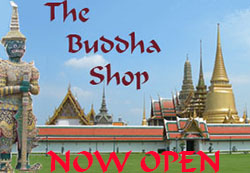Wat Pa Mak
Wat Pa Mok
Ayutthaya was considered to be part of Thailand’s glorious past. Pa Mok is well known for its abundant water jasmine trees. This temple was once known as Monastery of the Market or Wat Talat before it was renamed as Wat Pa Mok. This temple features a reclining Buddha 50 meters long. The beautiful image of Buddha is known as Phra Buddha Saiyat. The area where the temple stands was mentioned in the Royal Chronicles of Ayutthaya. It is one of the strategic passageways during the time of war. A canal that connects the Chao Phraya River and Burma was used by armies of both sides as a passage way. The old temple was built in late Ayutthaya period whereas the Buddha image was built during the Sukhothai period.
King Naresuan visited this temple during his reign (1590 until 1605) to pay homage to the reclining Buddha of Pa Mok before his battle with Burma. The battle was known as the Elephant Battle or referred to as Battle of Nong Sarai. In a prophetic dream, King Naresuan was visited by a large crocodile that he fights with. He was able to kill the beast. This was interpreted by the Brahms as a sign of victory for the king and his troops. A painting depicting this scene can be found in another temple (Wat Suwan Dararam). The story continues as the king mounted his elephant and saw a relic of the Buddha appearing in the skies. He prayed for a victorious battle.
Around 1725, the abbot of Wat Pa Mok informed Phraya Racha Songkhram to inform him that the river had eroded. As a result, the river banks may collapse at any moment taking the Buddha along with it. The Phraya came to investigate and offered the king his observations. He also offered his services of restoring the Buddha image. It took at least five months to take the pavilion down in order to finally move the Buddha. The image was then carried and deposited to a lorry.
A three day celebration of sorts occurs to celebrate the moving of the Buddha into its present location. A new base was constructed underneath it. After completing the work on the image, a new vihara was built. Several buildings were added to house the scripture hall, seminary and funeral monument. It was not long before the King died in 1733. A new king was appointed in 1734 named King Borommakot who dedicated the finished temple. For three days he was patient enough to listen to the Buddhist say their prayers. About 300 monks were gathered for this inauguration. They were offered all sorts of gifts like food, cloth and other items that were given as alms.
During the last day of the festivities an elephant tusk toughening ceremony was held. Before a heavy storm took place, the king had returned to Ayutthaya with his army. In 1901, during the reign of King Chulalongkhorn, he found the Buddha image damaged. He ordered it to be repaired. During the repairs, text was discovered on its back side. It was a royal poem about Phra Phuttha Saiyat Wat Pa Mok. The poem was composed of 69 chapters.
These chapters were dated during the period of King Thai Sa during Prince Phon (who later become King Boromakot) reign. Today, during the month of March and in October, a Long Boat Race Festival is held within the compound of this temple. The celebration in March is more about Wat Pa Mok reclining Buddha while the October festival has to do with the traditional long boat racing.
How to Get There
Wat Pa Mok is located in the right bank of the Chao Phraya River in Pa Mok District. The temple is open all days of the week.

